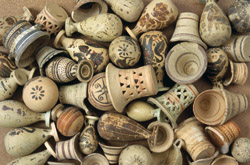Artifact Reference Collection

A reference collection of over 80,000 objects, dating from Neolithic to modern times and including pottery, sculpture, architecture, inscriptions, glass, metal work, architectural terracottas, figurines, and other terracotta objects, is maintained for the benefit of visiting and resident scholars. Most objects have been published in individual volumes of the Corinth monograph series, in preliminary reports in Hesperia, or are presently under study. Since 1977, about 1/2 of the registered material has been electronically cataloged while retro-conversion of old records is a continuing process. Online databases of artifacts are available at ascsa.net.
While large collections of finds are stored according to material or type of artifact, other groups are stored according to their find location, for example the grave groups from the North Cemetery and the finds from the Potters’ Quarter. Parts of the pottery collection have been grouped into ‘study collections’ covering different periods; Early Neolithic to Early Helladic II, Hellenistic, Roman, Byzantine and Early Modern. In addition a large collection of context pottery and small finds is stored in separate buildings. These provide useful deposits for chronological and spatial study of the site. Many of these contexts have been saved in their entirety. The collection of anatomical votives from the Asklepieion is unique, while the test pieces, wasters, misfired vases, various moulds for figurines from the Potters’ Quarter testify to the ancient city’s pottery and figurine production. The Julio-Claudian statues, the theater reliefs, mosaics from villas outside the forum, elaborate glass vases, statues of gods and emperors, bear witness to Corinth’s prominence in Roman times. Locally produced Byzantine pottery competes with various imports from Constantinople and Italy, and a steadily growing collection of modern artifacts rounds out over 8000 years of archaeological history in Ancient Corinth.
